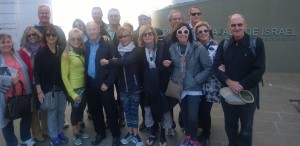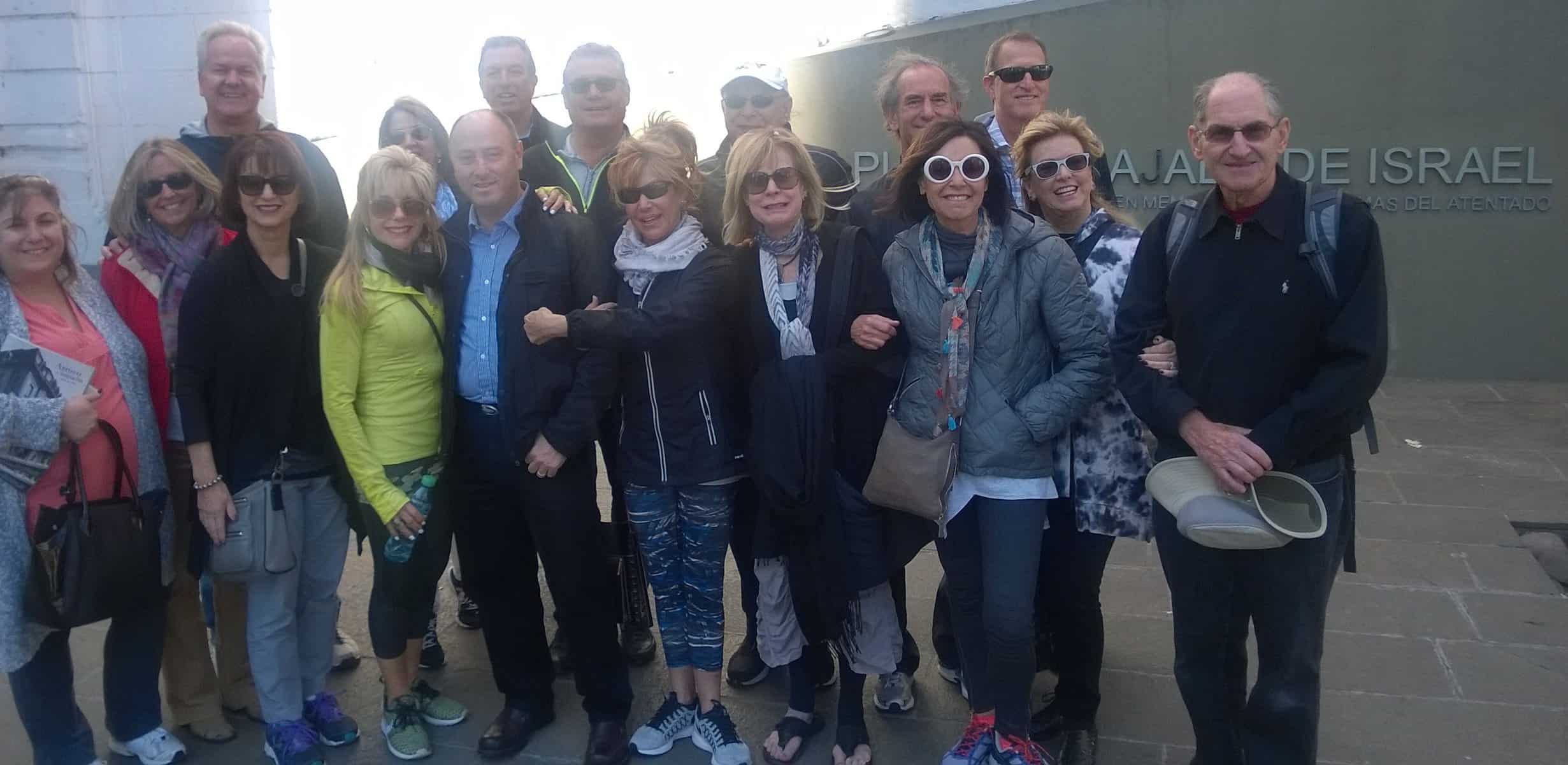Sixteen members of the Tidewater Jewish community recently returned from a special mission to the Jewish community of Buenos Aires, Argentina. The mission, sponsored by the United Jewish Federation of Tidewater, allowed local donors to “follow their campaign dollars” to one of the many overseas communities served by Tidewater’s Annual Campaign.
The next few issues of Jewish News will share “Postcards” from the mission, highlighting some of the most impactful experiences.

Amy Zelenka, Stephanie Calliott, Don London, Ilana Benson, Michelle Mahoney, Joan Joffe, Mark Gonsenhauser, Victor Nisembaum, Nathan Benson, Charlene Cohen, David Cohen, Leslie Siegel, Larry Siegel, Maggie Erickson, David Maizel, Honey Maizel, and Eric Joffe.
Postcard from the former site of the Israel Embassy in Argentina
The mission arrived in Buenos Aires just weeks after the suspicious and untimely death of special prosecutor Alberto Nissman. Nissman had been appointed by the government to investigate the 1992 and 1994 bombings of the Israel Embassy and the AMIA (Federation) building. Many of the locals the mission group encountered felt that Nissman, a successful Jewish attorney, had in essence signed his own death sentence, by appearing on national television and announcing that he was days away from presenting the findings of his investigation. Those findings, he said, would implicate some of Argentina’s highest ranking officials. Days later, Nissman was found dead in his apartment on the 13th floor of the luxury Le Parc tower complex in the expensive Puerto Madero neighborhood of Buenos Aires. Nissman’s mysterious death (and the subject of his investigation) was therefore never far from the thoughts of the participants or those with whom they met.
Accompanied by a wonderful guide, Paola, and a terrific educator, Dan, the group visited various Buenos Aires neighborhoods. Also traveling with the group were two security guards, Alberto and Gustavo, who had worked for the Israel Embassy in Argentina in 1992 when the building was bombed. They arranged a special meeting for the group at the former site of the Embassy with one of their former colleagues. After walking from the hotel to the site, which is now a memorial, the group was met by Victor Nisembaum, who shared his personal story, focusing on the day of the bombing.
Nisembaum spoke candidly about the seconds and moments following the bombing. The building had collapsed, and an eerie silence settled over the rubble under which he’d been trapped. Nisembaum had been so buried that when he opened his eyes to find a way out, he saw only black. He later found out that his ear drums had been blown–out during the bombing. So seeing nothing and hearing nothing….he literally struggled to determine whether he was dead or alive.
As the initial shock wore off (in what seemed like hours, but was only minutes), Nisembaum began to focus his vision on a point of light slowly making its way into his awareness. It was then he realized he was in fact alive, and that he could fight his way out from under the rubble. And so he did. On coming to the surface, the site which greeted him was horrific, but his security training kicked in, and he started to run down the street. The buildings for several blocks had been damaged, so he ran and ran until he found a storefront with a working phone. Then he made two calls. The first was to his mother. “There’s been a bombing, but I’m alive!” he shouted into the receiver (not sure anyone had even picked up the phone on the other end). Next he placed a call to his boss in Israel. Here again, he waited what seemed like a reasonable amount of time to allow the call to connect then shouted into the phone: “Our embassy in Buenos Argentina has been bombed! You must send a team!”
Anyone familiar with the Argentine government and law enforcement, Nisembaum explained, would immediately understand that any investigation they led was bound to be compromised in some fashion. He then ran back to the site to assist with recovery operations.
Also destroyed in the bombing that day were a Catholic church and a nearby school building. When all was tallied up: 29 people were killed (four were Israelis, but most were Argentine civilians, many of them children); and 242 were wounded. It was Argentina’s deadliest terror attack until the 1994 bombing of the AMIA (Jewish Federation) building, and it remains the deadliest attack on an Israeli diplomatic mission.
Left to stand in memory of the victims of the 1992 bombing is a “ghost” of the embassy—an outline of the original building on what had been a neighboring building. Where the embassy had stood now stands a plaza with trees and benches —a rare peaceful spot in the midst of a bustling city neighborhood. On the wall is a plaque with the victims’ names.
After sharing his story with the group, Nisembaum showed them a commemorative book, which had been printed on the 23rd anniversary of the bombing and given to the survivors and families of the victims. The book depicted “then and now” photos. It was heart-wrenching to see the faces of those whose lives were lost in the bombing—and to comprehend the vast potential for good which went with them —but it was incredibly inspiring to see Nisembaum’s own pages, which showed a strapping young security officer, uniform covered in dust and eyes haunted by the experience; then a facing photo of an older Nisembaum, now married with multiple children on his lap—a victim no longer. Today, he is a survivor with a story to tell and a father with a gaggle of children about which to kvell.
Next stop.… The “new” AMIA building in Buenos Aires.
by Amy Zelenka

